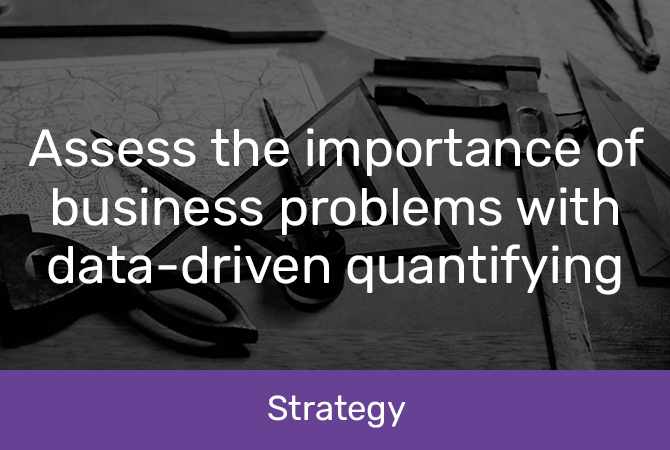
Assess the importance of business problems with data-driven quantifying
Unsure of the cause of your pain? Quantify it.
Every business has problems – you can likely ramble off a long list without thinking about it. What’s equally valid is that most organisations don’t have the time, budget or personnel to solve all those problems. So, how do you know which ones to fix?
Understanding the scale and severity of each business problem is key to determining where to put your time and resources. Without quantifying the size and impact of a problem, you’ll likely fix the wrong things – which only leads to more problems.
Data and analytics can significantly help quantify and prioritise business problems. This ensures that the most critical issues receive attention first, and budget and effort are directed towards solutions that provide the greatest return on investment.
What is data-driven quantification?
Data-driven quantification uses data analysis to measure and evaluate performance, outcomes and trends. Using statistical methods and advanced analytics, organisations can translate complex data into actionable insights that help determine the most effective solution to a business problem.
Why are quantifying business problems important?
Quantifying the size of business problems with data is crucial because it provides a clear understanding of an issue’s impact on performance and resources. Rushing to fix problems without accurate measurement can lead to misguided decisions, wasted resources and potentially exacerbated issues. Data-driven insights allow decision-makers to prioritise problems based on severity and potential return on investment. By analysing and quantifying business problems, every effort is efficient and aligned with your overall business goals. You can implement targeted, practical strategies that address root causes and improve outcomes for long-term stability and growth.
Benefits of quantifying business problems with data
There are multiple solutions for every business problem. Quantifying business problems with data will help you determine the most effective courses of action. Leveraging data analytics will give you a clearer picture of your challenges. With that clarity, you can tackle issues strategically, leading to improved operational efficiency and long-term success.
Here are some key benefits of quantifying business problems:
Informed decision-making
Data quantification provides objective insights that help leaders understand the scale and impact of issues. This clarity promotes well-informed decisions rather than relying on gut feelings or anecdotal evidence.
Prioritisation of resources
Data analysis lets you allocate resources more effectively by identifying the most significant problems. This ensures that time and budget are focused on areas that will yield the highest return on investment.
Measurable outcomes
Quantifying problems establishes baseline metrics for tracking progress and measuring the effectiveness of implemented solutions. This accountability promotes continuous improvement, as teams can see the direct impact of their actions on performance.
Risks of not using data-driven quantification in business
Failing to use data-driven quantification in business poses significant risks that can hinder growth and operational effectiveness.
Without a solid analytical foundation, you may face these challenges:
Misguided decisions
Without accurate data, decision-makers fall back on intuition or anecdotal evidence, leading to misguided strategies that don’t address the root causes of problems. This can result in wasted resources and missed opportunities.
Ineffective resource allocation
Organisations that don’t quantify problems may misjudge their severity, leading to ineffective allocation of time, money and personnel. This can divert attention from critical issues that require immediate intervention.
Lack of accountability
Without data to measure outcomes, assessing the effectiveness of initiatives becomes challenging. This lack of accountability can cultivate complacency and stifle a culture of continuous improvement. Teams may not feel compelled to innovate or adapt based on results, which can hinder their ability to respond effectively to market changes. Ultimately, this jeopardises the company’s competitive edge and long-term viability.
 How does Datamine help businesses quantify their data?
How does Datamine help businesses quantify their data?
It can be hard to see the forest for the trees. That’s where getting an outside perspective can help you approach your business problems more objectively.
Our practical, collaborative and outcomes-focused workshops help remove bias from your data conversations. They provide a structured approach that aims to deliver a robust framework for prioritising issues, allocating resources effectively, and making informed decisions that drive strategic and commercial initiatives.
Envisaging workshop
Are you starting a project, transitioning, or re-aligning teams? This workshop will help everyone agree on your long-term vision, opportunities and goals. You’ll walk away with a list of prioritised opportunities to make money or improve the business.
Solution Design workshop
In this workshop, you’ll move from big-picture ideas to specific problems and solutions, factoring in costings, responsibilities and timelines. You’ll dive into the priorities you set in the Envisaging workshop and determine clear problem statements, costs and proposed solutions.
Book your Envisaging workshop now.
Effectively quantify your business problems with Datamine
At Datamine, our goal is to help you navigate the complexities of data management and transform that overwhelm into clear, actionable insights that drive real value for your organisation. With our extensive expertise in the data landscape, we offer a comprehensive range of data and analytics services, including data strategy and advanced analytics.
While it can be tempting to jump straight into taking action, quantifying the size of the pain or problem must come first. You need to know what to solve first to deliver the outcomes you want. From there, developing a strategic roadmap tailored to your business needs and goals will ensure that every move is impactful, backed by data, and involves the right people and perspectives.
Take control of your data and turn insights into tangible business outcomes. Talk to the Datamine team to start your data journey today.
Data and analytics quantification FAQs
What kind of problems can be quantified with data?
Almost any problem can be quantified, including customer churn, operational inefficiencies, marketing performance, supply chain bottlenecks, and more. Datamine helps you identify the best approach to measure and evaluate these issues.
Can we ask our internal teams to quantify our business problems in this way?
Many organisations face challenges such as limited expertise, insufficient resources or biases that can cloud internal assessments. External partners like Datamine bring specialised skills, proven methodologies and an objective perspective to ensure your organisation gets the full benefit of any analytics project.
Can Datamine help with specific problems?
Yes, that’s precisely where Datamine excels. Engage our team to work on a targeted project, and we’ll make sure that you’re focusing your resources on solving immediate, high-priority challenges. We can also help train and upskill your internal teams so you build capacity for future projects.
Can Datamine work with our existing systems and processes?
Yes, Datamine works within your current framework, leveraging existing tools and data while recommending improvements where necessary. This minimises disruption and maximises the impact of the project.
Further reading


















































![20221205 Market Share - the Kingpin of Marketing Analytics [LinkedIn]](https://www.datamine.com/hs-fs/hubfs/Images/Datafix%20Blog%20Feature%20images/2022/20221205%20Market%20Share%20-%20the%20Kingpin%20of%20Marketing%20Analytics%20%5BLinkedIn%5D.png?width=1200&height=627&name=20221205%20Market%20Share%20-%20the%20Kingpin%20of%20Marketing%20Analytics%20%5BLinkedIn%5D.png)




